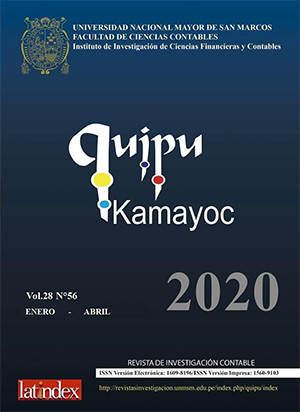Credit management audit and the profitability of the Prisma Microfinance Savings and Credit Cooperative (2014-2017)
DOI:
https://doi.org/10.15381/quipu.v28i56.17466Keywords:
Auditing, management, credits, risks, profitabilityAbstract
Objective: To determine how the credit management auditing has an impact on the profitability of the Prisma Microfinance Savings and Credit Cooperatives (COOPAC MFP). Method: The type of research is non-experimental, descriptive and explanatory. Primary source information was collected; it was obtained through surveys, interviews with credit and collection advisors and documentary and financial information about COOPAC MFP. Surveys, interviews with credit and collection advisors and documentary and financial information about COOPAC MFP were prepared. Results: It is evident that there is no good credit management in the recruitment of credit and collection personnel or in the evaluation processes for the granting of credit, nor supervision and monitoring of the risks and the overdue portfolio. Conclusions: There are no good practices of credit management auditing by credit and collection advisors, such as knowledge of credit policy and products to perform an evaluation, approval and recovery of credits, because they do not receive constant training; this creates a credit risk that has a negative impact on the profitability of the COOPAC MFP.
Downloads
Downloads
Published
Issue
Section
License
Copyright (c) 2020 Milena Guillen Sauñe

This work is licensed under a Creative Commons Attribution-NonCommercial-ShareAlike 4.0 International License.
AUTHORS RETAIN THEIR RIGHTS:
a. Authors retain their trade mark rights and patent, and also on any process or procedure described in the article.
b. Authors retain their right to share, copy, distribute, perform and publicly communicate their article (eg, to place their article in an institutional repository or publish it in a book), with an acknowledgment of its initial publication in Quipukamayoc .
c. Authors retain theirs right to make a subsequent publication of their work, to use the article or any part thereof (eg a compilation of his papers, lecture notes, thesis, or a book), always indicating the source of publication (the originator of the work, journal, volume, number and date).






